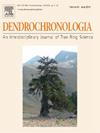Site and environmental legacies shape the growth–climate response of silver fir along a climatic and elevational gradient in Austria
IF 2.3
3区 农林科学
Q1 FORESTRY
引用次数: 0
Abstract
Silver fir (Abies alba Mill.) is a key forest tree species in Central Europe growing commonly in mixtures with beech and spruce. In forest sciences, the species has received wide attention due to the complex forest decline phase peaking in the late 1970s and the early 1980s in Central Europe, highlighting the negative effects of air pollution of that time. In the era of accelerating climate change with its adverse effects becoming apparent, the species is gaining renewed interest, especially for its further admixing potential to more resilient forest stands. In our study, we investigate the low-frequency radial growth patterns and changes, as well as the interannual variations and the corresponding climatic signal manifested in the tree-ring width chronologies of seven monospecific stands of silver fir. The study sites represent a broad climatic and elevational gradient along the distribution of the species. We compared the identified changes to recent climatic trends with more frequent dry periods since the 1980s, with specific attention to the timescale of the preceding forest decline phenomena. Following decades of radial growth decrease, culminating in severe decline at some sites, a quick recovery and increasing growth marked a period after the early 1980s, regardless of tree age and most pronounced at lower-elevation sites. The period of growth depression and recovery was accompanied by weakened or altered interannual climatic signals. During the recent decades, mean growth has been decreasing again at lower-elevation sites coinciding with drier conditions and shows signs of similar tendencies at some of the humid sites. A recent strengthening of the hydroclimatic signal, however, was not uniform in its timing among the sites. The interpretation of the results can help to further assess the resilience of silver fir to environmental stress, at the crossroads of past legacies, current and predicted challenges.
地点和环境遗产塑造了奥地利沿气候和海拔梯度生长的银杉的气候响应
银杉(Abies alba Mill.)是中欧重要的森林树种,通常与山毛榉和云杉混合生长。在森林科学中,由于复杂的森林衰退阶段在20世纪70年代末和80年代初在中欧达到顶峰,突出了当时空气污染的负面影响,该物种受到了广泛关注。在气候变化加速及其不利影响日益明显的时代,该物种正重新引起人们的兴趣,特别是因为它具有进一步混入更有弹性的林分的潜力。本文研究了7个银杉单株林分的树轮宽度年代学中所表现出的低频径向生长模式和变化、年际变化及其相应的气候信号。研究地点代表了沿物种分布的广泛的气候和海拔梯度。我们将已确定的变化与自20世纪80年代以来干旱期更为频繁的近期气候趋势进行了比较,并特别关注了之前森林衰退现象的时间尺度。经过几十年的径向生长下降,在一些地点达到严重下降的顶峰,在20世纪80年代初之后,无论树龄如何,树木的快速恢复和增长都标志着一段时间,在低海拔地区最为明显。生长萧条期和恢复期伴随着年际气候信号减弱或改变。在最近的几十年里,在低海拔地区,平均生长再次下降,与干旱条件相一致,在一些潮湿地区也显示出类似的趋势。然而,最近水文气候信号的加强在各地点的时间上并不一致。对结果的解释可以帮助进一步评估银杉对环境压力的恢复能力,在过去的遗产,当前和预测的挑战的十字路口。
本文章由计算机程序翻译,如有差异,请以英文原文为准。
求助全文
约1分钟内获得全文
求助全文
来源期刊

Dendrochronologia
FORESTRY-GEOGRAPHY, PHYSICAL
CiteScore
5.50
自引率
13.30%
发文量
82
审稿时长
22.8 weeks
期刊介绍:
Dendrochronologia is a peer-reviewed international scholarly journal that presents high-quality research related to growth rings of woody plants, i.e., trees and shrubs, and the application of tree-ring studies.
The areas covered by the journal include, but are not limited to:
Archaeology
Botany
Climatology
Ecology
Forestry
Geology
Hydrology
Original research articles, reviews, communications, technical notes and personal notes are considered for publication.
 求助内容:
求助内容: 应助结果提醒方式:
应助结果提醒方式:


